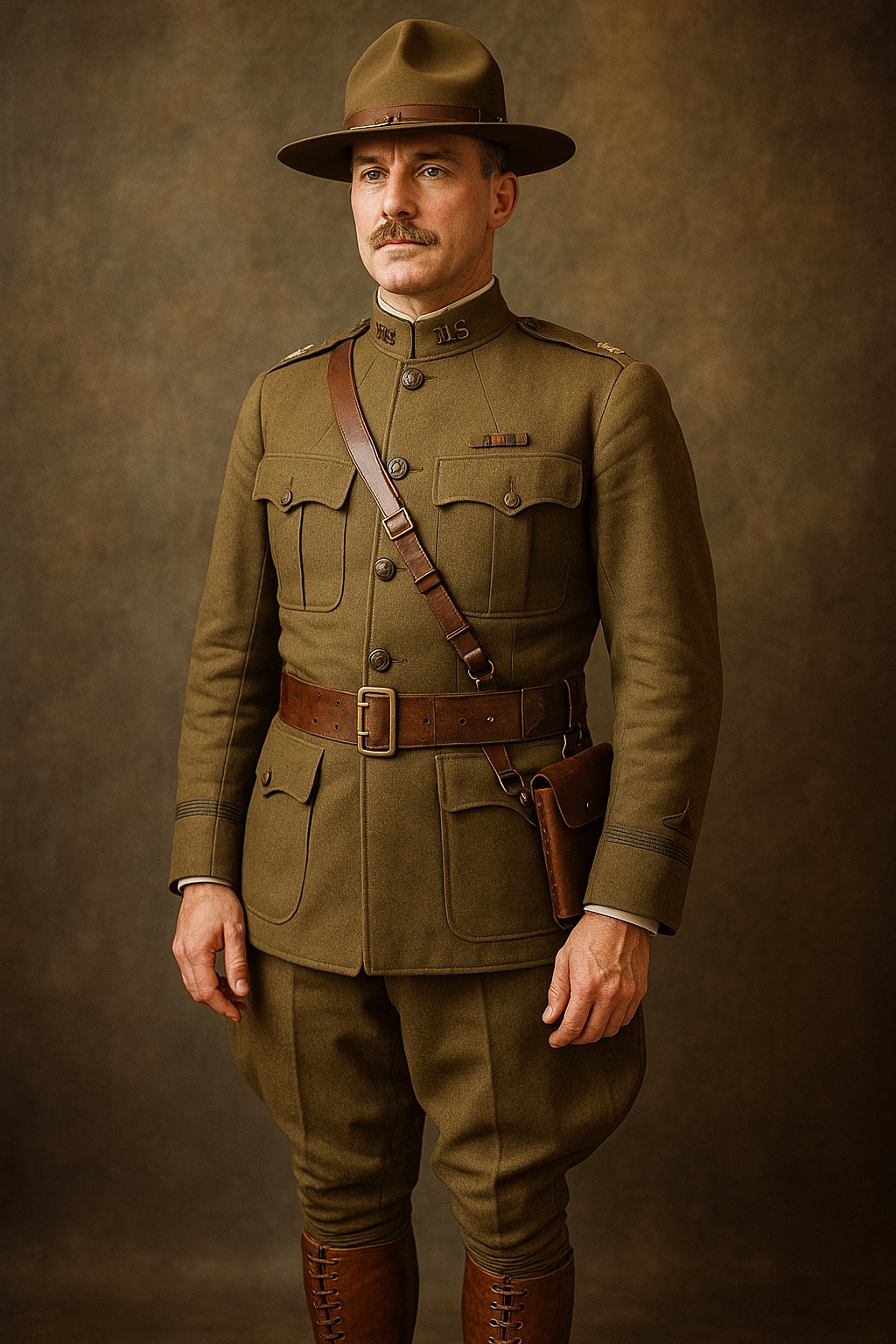
WWI US Officer Uniform: History, Style, and Legacy of American Military Elegance
Published on Jun 26, 2025
WWI US Officer Uniform: A Timeless Symbol of Honor and Military Tradition
Introduction
When we think of World War I, images of trench warfare and military innovation come to mind—but the WWI US Officer Uniform tells a story of its own. Beyond the battlefield, these uniforms represented discipline, tradition, and national pride. Unlike the mass-issued gear for enlisted soldiers, officer uniforms were often custom-tailored, boasting quality, distinction, and style. In this article, we’ll explore the core elements of the WWI US officer uniform, its historical context, and how it compares to the WWII British officer uniform and other notable military attire.
Historical Background: WWI and the American Officer Corps
The United States officially entered World War I in April 1917. At the time, the American Expeditionary Forces (AEF), led by General John J. Pershing, required a professional-looking and functional uniform for its officers. Influenced by British and French military styles, the WWI US officer uniform blended practicality with prestige.
Influences from European Uniform Design
American officers during WWI were often embedded with Allied forces and influenced by their uniform standards. Notably, the WWII British officer uniform would later adopt similar structured tailoring and fabric choices, drawing inspiration from these WWI styles. This makes the WWI US officer uniform a precursor to many Allied dress standards that followed.
Key Features of the WWI US Officer Uniform
1. Service Coat
The officer’s service coat was perhaps the most defining element:
- Color: Olive drab wool, slightly darker than enlisted versions.
- Cut: Fitted with four patch pockets and a belted waist, giving a sharp silhouette.
- Insignia: Collar devices and shoulder straps denoted rank and branch (infantry, artillery, etc.).
2. Breeches and Riding Boots
Officers typically wore matching wool breeches tucked into high leather riding boots—a nod to cavalry heritage and officer privilege. This contrasted with the puttees and canvas leggings worn by enlisted men.
3. Sam Browne Belt
Adopted initially from British forces, the leather Sam Browne belt with a diagonal shoulder strap was a standard issue for officers. It was both functional and stylish, allowing for a sidearm or map case attachment.
4. Campaign Hat and Overseas Cap
- Campaign Hat: Wide-brimmed, stiff-felt hat often seen in early deployments.
- Overseas Cap: A folding garrison-style cap introduced for practicality in Europe.
Dress vs. Field Uniforms
WWI officers had variations for different situations:
- Field Uniforms emphasized functionality and camouflage.
- Dress Uniforms were worn for ceremonies and command settings, often in finer wool and with polished leather accessories.
This tradition continues in modern military dress codes, reflected in the USMC evening dress uniform, and Marine Corps officer dress cover, which are direct descendants of these formal dress standards.
Comparison with WWII British Officer Uniforms
While the WWII British officer uniform is more commonly recognized today, its roots can be traced back to the WWI American design:
- Fabric: Both used wool, but the British adopted a lighter khaki drab.
- Cut: WWI American uniforms were slightly more structured, while British uniforms evolved to favor mobility.
- Headgear: British officers commonly wore peaked caps, whereas American officers alternated between campaign hats and garrison caps.
Both uniforms emphasized authority and professionalism, setting a benchmark militarily.
Modern Echoes: From Navy Chiefs to Marine Corps Officers
Navy Choker White Chief
The white chief dress uniform worn by naval personnel shares ceremonial significance with the WWI officer dress. The pristine white coat and trousers, often worn by senior naval chiefs, emphasize tradition and rank—much like the WWI service coat.
Marine Corps Officer Dress Cover
This iconic peaked hat completes the Marine Corps dress uniform, much like the Sam Browne belt completed the WWI officer look. Both elements convey authority and command presence.
USMC Mess Dress Officer Uniform
Drawing from the formality of WWI military attire, the USMC mess dress officer uniform carries forward the tradition of elegance in military presentation. It is reserved for special events, mirroring the ceremonial dress of WWI officers.
Legacy and Collectibility
For collectors, historians, and reenactors, the WWI US officer uniform holds immense value:
- Authenticity: Original pieces are rare and highly prized.
- Craftsmanship: High-quality wool, brass buttons, and leatherwork showcase pre-mass production tailoring.
- Historical Significance: These uniforms represent a pivotal moment in US military history.
At Paddelaters.com, we honor this legacy by offering authentic reproductions and curated collections that reflect the detail and dignity of these uniforms.
Why the WWI US Officer Uniform Still Matters
The WWI US officer uniform is more than fabric and thread—it’s a story of leadership, honor, and evolution. It influenced later designs like the WWII British officer uniform, inspired dress codes still used today (as seen in chief dress white and USMC mess dress officer uniforms), and remains a symbol of American military heritage.
Whether you’re a collector, reenactor, or simply passionate about military history, understanding the depth of this uniform enhances your appreciation for the soldiers who wore it—and the legacy they left behind.
Conclusion
From the trenches of Europe to the ceremonial halls of modern military installations, the WWI US officer uniform continues to command respect. Its distinct design, rich history, and influence on military dress make it an essential topic for any military history enthusiast or collector. As you explore related styles—from WWII British officer uniforms to Marine Corps officer dress covers—you’ll find threads of continuity that began over a century ago.
At Paddelaters.com, we’re proud to keep this history alive with carefully crafted pieces that pay tribute to the past while serving today’s historians, collectors, and enthusiasts.
